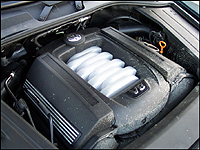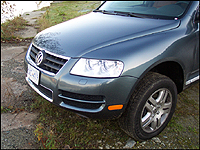I first tested this SUV, or at least its comparable second cousin, with a Porsche badge attached. OK, maybe that's not fair. In reality both sport utilities look very different inside and out. The two companies, having been previously joined at the hip, and also having paired up in the past to develop the Porsche 914 and 924/944, plus various technologies that benefited VW, came together to develop the Cayenne and Touareg SUVs. The result is a Jeckyl and Hyde combination of refinement and ruggedness, perfect for the intended purpose.
 |
| The 40-valve 310-hp V8, with its 302 lb-ft of torque does a good job of moving the 2,404 kg (5,300 lb) Touareg forward. (Photo: Shawn Pisio, Canadian Auto Press)
|
Porsche offers its own more powerful engines, except for its new base model that will share a slightly tuned version of Volkswagen's 3.2-L V6. VW's engine choices start with that engine, rated at 220-hp at a fairly peaky 5,400 rpm and 225 lb-ft of torque at 3,200 rpm. Now that I've driven it I can appreciate just how hard its V8 has to work in order to tug the hefty 2,404 kg (5,300 lb) sport utility up a hill, therefore I can't see how the V6, despite its weight reduction to 2,307 kg (5,086 lbs), could possibly feel energetic. But I haven't driven it, so I can't really say for sure.
 |
| While the V8 isn't as snappy as when it's in the Audi A6, the Touareg is by no means sluggish. (Photo: Shawn Pisio, Canadian Auto Press)
|
The 40-valve 310-hp V8, with peak power coming in at an even loftier 6,200 rpm and maximum torque of 302 lb-ft available at 3,000, does a good job amassing forward momentum. While it doesn't snap to action as authoritatively in the Touareg as it does in the midsize Audi A6 sedan, it couldn't be called sluggish. It could be called thirsty however, costing me $36 dollars after a day and a half of regular city driving. Fortunately there was a 15 cent per liter gas sale going on at the pumps, or it would have cost me more. Volkswagen will address this problem by offering a powerful V10 diesel next year.

